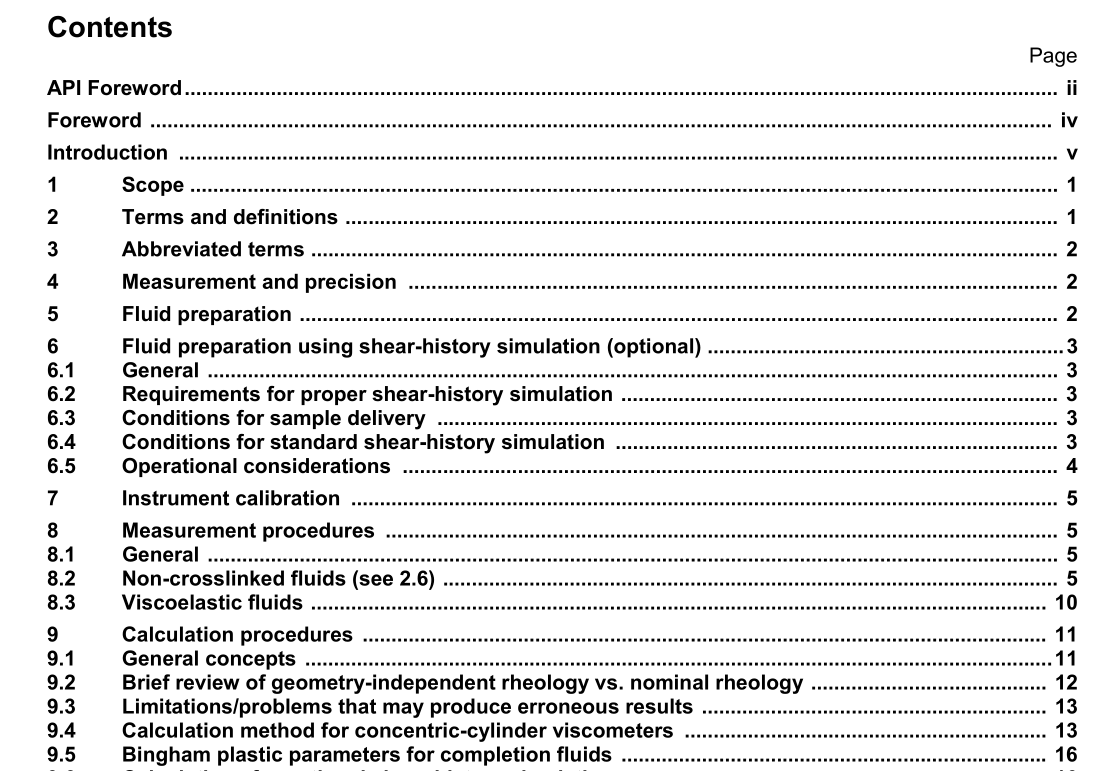API RP 13M pdf download

API RP 13M pdf download.Recommended Practice for the Measurement of Viscous Properties of Completion Fluids
2 Terms and definitions
For the purposes of this document, the following terms and definitions apply. 2.1 bob fixed inner cylinder of a concentric-cylinder viscometer 2.2 completion fluid any fluid used during the completion phase of a well 2.3 concentric-cylinder viscometer rotational viscometer that consists of a concentric-cylindrical bob and a cylindrical rotor 2.4 elasticity capability of a material to regain its original shape and condition upon removal of an acting stress 2.5 laminar flow flow property of fluids in which all layers of the fluid move parallel to each other and no material is transferred between layers 2.6 non-crosslinked fluid linear, polymer-viscosified solution or any fluid that does not exhibit significant elasticity leading to the Weissenberg effect (“bob climbing”) 2.7 rheology science of the deformation and flow of matter 2.8 shear history sequence of shear rates and temperatures applied to fluids prior to and during measurements 2.9 shear-history simulator apparatus used to simulate shear history in a fluid 2.10 shear rate rate at which one particle of fluid is sliding by another particle divided by the distance between those particles 2.11 shear stress force required to sustain fluid flow 2.12 viscoelastic fluid crosslinked polymer solution or other fluid that exhibits significant elasticity, leading to the Weissenberg effect (bob climbing) 2.13 viscosity measure of the internal friction of a fluid when caused to flow by an external force
5 Fluid preparation
Certain aspects of sample preparation and handling can affect the viscosity or rheological properties of a fluid. During all procedures, steps shall be taken to minimize entraining air into the fluid. Following preparation, all fluids, except those intended to be used as fracturing fluids, shall be filtered through a filter of pore diameter 2 µm. Minimize the entrainment of air during the filtration process. The procedure used to prepare the fluid sample shall be documented including the following information: a) description and/or composition of the base fluid. Preparation of the fluid shall be described, starting with the fluid source, such as deionized water, tap water, seawater (location), or type of oil; b) identification of mixing apparatus, container volume, and total volume of fluid prepared; c) identification of each fluid component and amount added; d) the order and method of addition of each compone e) mixing speeds, with time at each speed; f) ageing or holding time prior to measurements, if required; g) temperature (required only for fracturing fluids); h) pH (for aqueous fluids, where applicable); i) all other aspects of the fluid preparation which are known to affect the outcome of the viscosity measurement should be reported.
6 Fluid preparation using shear-history simulation (optional)
6.1 General A shear-history simulation procedure is provided to simulate the effects of shear rate and time while a fluid is being conveyed down well tubulars. This procedure is intended to characterize the effect of shear history on fluid properties as part of the concept and development phase for a new fluid. A shear-history apparatus is used to condition the fluid at specified shear rates, times and temperatures prior to injection into a viscometer. It consists of mixing apparatus, pumping apparatus and tubing to simulate significant aspects of the surface apparatus followed by shear conditions in the well tubulars. A shear-history apparatus that satisfies the requirements can be generically classified as a tube or pipe flow device that operates in the laminar flow regime. Flow shall occur in a single-pass mode. A schematic diagram of a shear-history simulator connected to a pressurized concentric-cylinder viscometer is shown in Figure 1. In laminar flow, the energy dissipation rate is the same in any shear-history apparatus even if different tubing sizes are used. Thus the design and functioning of the apparatus can vary and still meet the desired preconditioning criteria.









